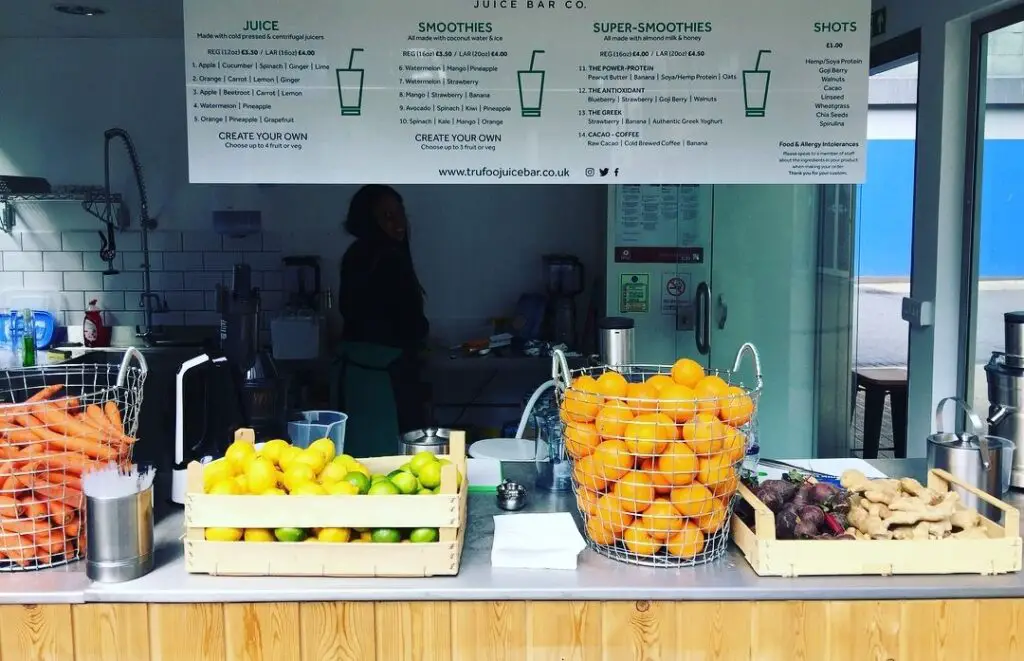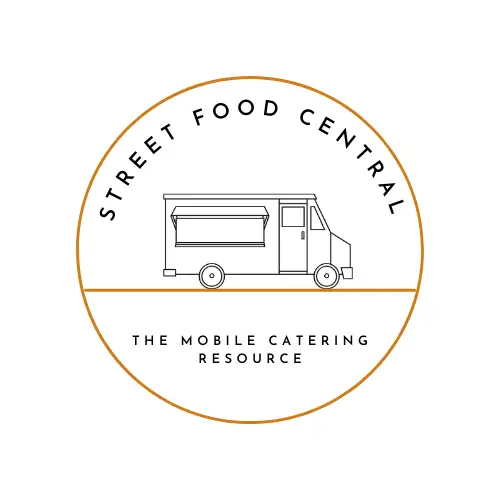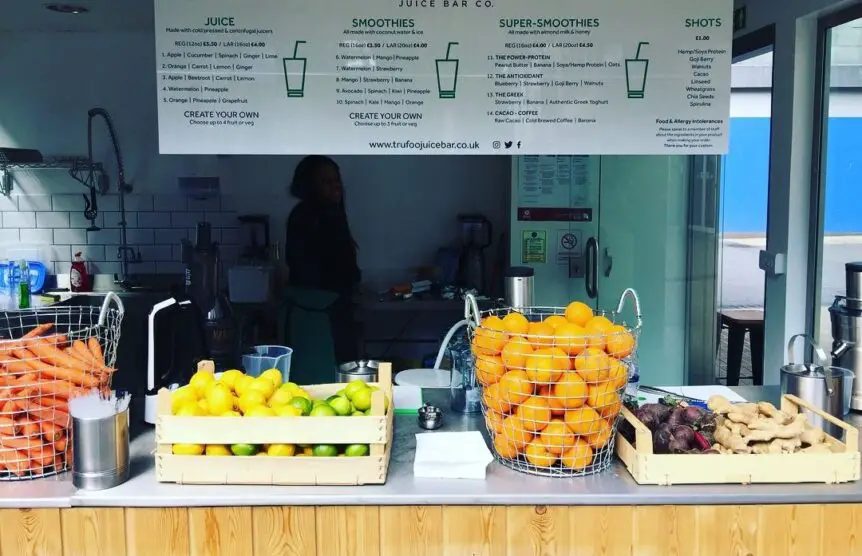See how to start a juice bar by a juice bar owner with over 7 years of experience and get insider tips

Starting a juice bar can be a great business idea because it not only taps into the large and growing health and wellness market but also has a relatively low barrier to entry and is a less labor and equipment-intensive operation than other types of hot food restaurants.
Despite it being a relatively easy business to get into there are a number of important steps you need to take to maximize your chances of success over the short and long term.
Some of the steps you need to take to start a juice bar include making a business plan, securing funding, finding a suitable location, creating a juice menu, purchasing equipment, and finding reliable wholesale suppliers for your fruit and vegetables.
There are also a few more things you need to do which I will go into in more detail in the article along with some insider tips that I’ve learned over the years.
Contents: How to start a juice bar
- Make a business plan
- Secure funding
- Choose a business name
- Design your branding
- Create a menu
- Make an equipment list
- Find suppliers
- Hire
- Get licenses & certificates
- Find a location
- Develop a marketing strategy
- Insider tips
- Related questions
1. Make a business plan
Creating a business plan is the first and one of the most important steps you will take when starting any business and will ultimately determine if you are a success or failure.
It helps you to understand your target audience (such as age, gender, education, and income), identify your competitors, plan marketing strategies, and clarify your goals and objectives so you have a clearer path to where you want to get to.
It also will help you get start-up funding from banks, financial institutions, and other investors which will we discuss below.
Related article: How to Write a Business Plan, Step by Step
2. Secure funding
There are a few different routes you can go to get funding to start a juice bar. A start-up loan from a traditional bank or commercial lending company, government micro-loans, and grants, credit cards, crowd-sourcing, money from family and friends, or your own savings.
I’m not a financial adviser and everyone’s situation is different but I would raise the funds through family and friends and your own resources, which is what I did when I started out.
This limited the risks and if you fail you only fail once as opposed to losing your business and still having to repay a loan plus interest to a financial institution.
Related article: 13 Types of Business Loans: Find The Best Loan
3. Choose a business name
Next, you need to decide on a business name for your juice bar. You want your business name memorable and unambiguous and include in the title what you sell to convey what you do as a company.
A good tip for naming a business is to combine a location or name with the product. Joe and the Juice for example is a popular juice bar, which in my opinion conveys very effectively that it’s a juice bar.
You also want to check if the name is not already being used by checking the US Patents Office (US) or Companies House (UK) and then Trademark your business name with the relevant authorities.
Related article: 17 Tips For Naming Your Food Truck
4. Design your branding
Once you have decided on the name of your juice bar it’s time to get on with the branding and creating a logo. Luckily Juices and smoothies are great products for branding because of the array of eye-catching colours they come in.
Good branding is important for not only establishing your identity but also building trust, adding value and influencing people’s purchasing decisions.
You can hire graphic designers to help with this process on sites such as Fiverr and 99designs relatively cheaply. There are also a number of platforms that make it easy to create toy own logo and branding if you want to do it yourself such as Canva and Logo Maker.
5. Create a menu
Creating the juice and smoothie menu is the fun part for me. There are almost endless combinations so you will never get stuck for juice and smoothie ideas.
Get an editable menu that you can change over time as you test what drinks are the most popular and then adapt accordingly. I find green juices and mango and strawberry smoothies sell well.
A good tip is to have around 10 drink options on the menu (more if you do food). This makes it easy for inventory control and helps customers make easier decisions because they are not overwhelmed with too many choices. You can also have a mix-and-match option on your menu so customers can make their own combinations.
Related article: How Many Menu Items Should A Food Truck Have?
6. Make an equipment list
In comparison to other types of restaurants that have large hot food menus, juice bars need less equipment to operate as they mainly use cold products such as fruit and vegetables.
Here is a juice bar equipment list for the main things you will need:
- Juicers – For juice-based drinks such as cold press juice
- Blenders – For whole fruit smoothies
- Fridges – To keep produce cold
- Freezers – To extend the shelf life
- Ice machine – For juices and smoothies
- POS system (card & cash payments) – To take payments from customers
- Stainless steel surfaces – For food preparation and processing
- Shelves – To store produce, stock, and general business items
- Waste bins (recycle, food, and general waste) – Do dispose of waste ethically and safely
- 2 separate sinks – For personal hygiene and sanitation (washing hands and produce)
- Large plastic containers – To store pre-chopped fruit and veg (saves time)
- Sharp knives – For prepping fruit and vegetables
- Disposable packaging – For serving your products in
- Tables & chairs – To create a customer seating area
Related articles:
- What Equipment Is Needed For A Juice Bar?
- 5 Best Commercial Cold-Press Juicer Machines (2023)
- 5 Best Heavy-Duty Commercial Smoothie Blenders UK (2023)
7. Find suppliers
Aside from your juice bar equipment you also need to find wholesale suppliers for your fruit and vegetable and other complimentary items like coconut water and nut milk.
Finding suppliers that a reliable (they deliver when they say they will) and are competitively priced will all help with your bottom line and the service you ultimately provide. It’s also a good idea to find a supplier close to where you operate as it not only reduces your carbon footprint but is also easy for you if you have to collect your order.
8. Hire Staff
Starting and running a juice bar involves many roles from food production and customer service to administration and driving. This means you will want to hire staff, which you can do relatively easily by word of mouth, advertising on online job boards, and signing up with recruitment agencies.
However, if you are on a tight budget, and want to keep costs low it’s worth thinking about getting friends and family to help out, initially at least. Then when you prove your concept and start to bring in some revenue then hire staff.
9. Get licenses and certificates
The type of licenses you will need to run a juice bar will differ from country to country. But in the general, the types of licenses, permits, and certificates you will need to protect yourself as a business and operate legally include:
- Choose a business structure – Most small businesses operate as either a Sole Trader (Sole Proprietor) or a Limited Company (Limited Liability Company).
- Register for tax – Register as a company to pay the correct tax with the IRS (US) or HMRC (UK). The type of business structure you have chosen will influence how much tax you pay.
- Get Insurance – Common types of insurance include Public Liability Insurance, General Liability Insurance & Workers’ Compensation Insurance
- Get a Business license – Needed in some states in order to do business
- Food handler permit – Need to prepare and process food and supervise others if you are a manager
- HACCP Plan – This shows you have a system in place for how your food is transported, stored, and cooked.
Related article: Restaurant insurance: The top types of coverage every restaurant needs
10. Find a location
As the old saying goes, “Location, location, location”. Aside from the first step of market research finding the right location is absolutely critical for determining how well you will do going forward.
Ideally, you need to find a location in a high footfall area such as a city center, business district, or place that is frequented by a lot of tourists (a combination of all 3 is ideal).
You also want to think about the demographics of the area you want to operate in, such as age and if the people have high enough disposable incomes.
And you don’t have to actually have a fixed location. Another thing you may want to consider is going mobile with a juice food truck. All the steps you need to take to start a juice bar are practically the same, but you would just need to purchase a food truck or trailer.
One of the largest benefits of this is that you can go to where the footfall is and move if it drops off.
11. Develop a marketing strategy
Marketing your business is an open-ended process that you should be doing before, during, and after you have opened your juice bar.
It’s where you can build anticipation by letting people know what’s coming soon; involve them in the development of your juice bar by creating a “behind the scenes” video of how things are going in the shop things are going and retain and attract new customers.
Some of the best ways to do this are to leverage the power of social media and use platforms such as Instagram and TikTok.
You also want to create a website for your juice bar business as it makes you look like a professional business and is a place people can go for inquiries. You will be surprised what opportunities you new through existed when you have a website.
12. Insider tips
Now for some insider tips from someone who has been running a juice bar in one form or another (juice shop, juice truck, and juice stall) for over 7 years.
Account for seasonality & Climate
A lot of juice bars do not get past their first year due to seasonality and climate. Juices and smoothies are cold products which means they are very popular in the summer but not so much in the winter and if you are in a cold climate sales will drop dramatically.
To compensate for this and help your chances of success open in a place that has warm weather for a large part of the year, or if this is not an option diversify your menu to include hot drinks such as tea and coffee and hot food like healthy wraps or soups.
Pre-chop your produce
One of these is to pre-chop your fruit and vegetables for your smoothies and juices the night or the morning before. This will save time if you have a very busy period and speed up the process of serving customers.
Get movable tables
This may seem like a little thing but having pop-up or removable tables (as opposed to fixed) makes things much easier if you decide to change the layout of your kitchen. Having movable tables is also good if you decide to do any food preparation outside.
Have a mobile unit option
Having a mobile juice bar unit such as a truck, trailer or stall is a great way to increase your juice bar revenue. You can trade a wide variety of events such as festivals, food markets, sporting events, and private events such as corporate gigs and weddings.
Offer a few options
I mentioned this previously but I thought I would emphasize this point again. Don’t overwhelm your customers with too many choices and make it easy for them to make a decision. I would suggest having around 8-10 options initially to see what sells the best and have a mix-and-match option for customers who want to create their own drink.
Go eco-friendly
Consumers are more eco-conscious today which means they take more interest in the products they buy and the packaging it comes in.
This means it is a good (and ethical) idea to serve your juices and smoothies in compostable or biodegradable disposable packaging such as cups, lids, and straws as you will probably find you will get a lot of questions about what your cups and straws are made from.
Gavin D is the founder of Street Food Central and Tru Foo Juice Bar Co. and has worked in the mobile catering industry for over 7 years.

